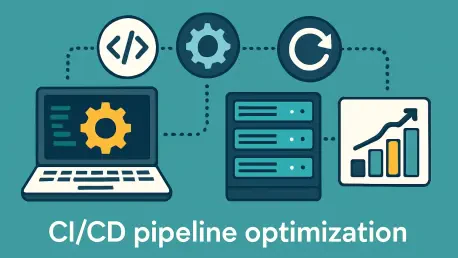What happens when a startup team, racing against tight deadlines, discovers that their own tools are slowing them down? In a world where every second counts toward launching the next big feature, a small development squad stumbled upon a game-changing realization: their Continuous Integration and Continuous Deployment (CI/CD) pipeline, meant to streamline work, had become a silent productivity killer. With developers waiting endlessly for builds to complete, frustration mounted—until a quick, five-minute tweak turned everything around, reclaiming hours of lost time each day. This story isn’t just about a technical fix; it’s about how tiny adjustments can fuel massive wins in the high-stakes startup arena.
Why a Simple Change Yielded Huge Results
Startups thrive on speed, yet even the fastest teams can trip over unnoticed inefficiencies. For this small group of developers, the CI/CD pipeline—designed to automate testing and deployment—had grown into a cumbersome hurdle. Hosted on GitHub Actions, the system triggered exhaustive builds for every code push, regardless of relevance, leading to delays that disrupted daily workflows. A mere five-minute adjustment to streamline these processes slashed wait times dramatically, proving that sometimes the smallest pivots can unlock the biggest gains.
This discovery wasn’t just a fluke; it highlighted a universal truth in tech. Overcomplicated workflows often creep in during rapid growth phases, draining resources before anyone notices. By addressing this overlooked issue, the team didn’t just save time—they redefined their pace of innovation, setting a powerful example for others navigating similar challenges.
The Heavy Toll of an Overloaded Pipeline
In the relentless push to ship features, infrastructure like CI/CD pipelines often slips under the radar. Yet, for this startup, neglecting their setup came at a steep price. What started as a reliable tool had ballooned into a bottleneck, with redundant jobs and unnecessary builds piling up. Each run took around 30 minutes, stalling developers and costing the team focus, momentum, and critical feedback on pull requests, not to mention a monthly GitHub Actions bill reaching up to $141 during peak times.
Beyond the financial hit, the human cost was even more glaring. Developers found themselves stuck, unable to iterate quickly or maintain a smooth rhythm. This mirrors a wider industry issue: unchecked technical debt in automated systems can quietly erode a team’s efficiency, turning a supposed asset into a liability that hampers progress at every turn.
Unpacking the Issue and Crafting a Winning Solution
How did this team transform a persistent drag into a productivity booster? The root problems were clear: the pipeline triggered full builds for every code change, even on minor feature branches, and backend builds ran sequentially, overloading servers with memory strain. A targeted fix took just minutes to implement—splitting backend builds into parallel jobs to lighten the load and adjusting triggers so only essential tasks like linting and testing ran automatically on pull requests, while heavier builds were reserved for the main branch or manual activation.
The impact was immediate and profound. Run times on feature branches dropped from a grueling 57 minutes to as low as 15, freeing up an estimated 5 hours daily across the team. This wasn’t just about cutting delays; it was about restoring rapid feedback loops that kept development cycles tight and efficient, showcasing how pinpointing specific flaws can lead to outsized improvements.
Insights from the Team: Tangible Gains and Hard Data
Hearing directly from those on the front lines reveals the true weight of this change. A developer shared, “Those 30-minute waits broke my focus—now, I’m back to iterating in half the time.” This sentiment aligns with broader research: studies indicate developers can lose up to 8 hours daily to workflow inefficiencies, costing companies thousands per person each year. For this startup, slashing wait times translated to an estimated savings of $13,445 annually per developer in productivity alone.
More than just numbers, the shift reinvigorated the team’s spirit. Faster feedback meant quicker iterations, smoother collaboration, and a renewed sense of control over their workday. These real-world outcomes emphasize a critical lesson: in a startup, where time is the ultimate currency, reclaiming it can redefine what’s possible.
Steps to Identify and Resolve Your Pipeline Issues
Could your team benefit from a similar turnaround? Auditing a CI/CD pipeline doesn’t require a massive overhaul—just a focused approach. Begin by mapping out every job in the workflow, pinpointing which tasks are crucial for specific branches and which can be delayed or skipped. Platforms like GitHub Actions often allow for customization, so look for ways to parallelize heavy tasks like builds to reduce server strain and speed up results.
Next, refine job triggers to ensure only necessary processes run automatically, conserving resources for pivotal moments like merging to the main branch. Track wait times before and after adjustments to measure the impact—aim for feedback cycles under 20 minutes. Regularly question the necessity of each step in the pipeline. Adopting this mindset of continuous refinement ensures that tools support progress rather than impede it, paving the way for sustained efficiency.
Reflecting on a Transformative Fix
Looking back, that five-minute adjustment became a turning point for the startup team, reshaping how they tackled daily challenges. It wasn’t merely about trimming wait times or curbing costs; it was about reclaiming focus and momentum in an environment where every moment mattered. The ripple effect of faster feedback and smoother workflows empowered them to deliver at a pace they hadn’t thought possible.
For other teams facing similar bottlenecks, the path forward lies in taking a hard look at internal processes. Start small—audit one workflow, test one change, and measure the outcome. Over time, these incremental improvements can build a foundation for lasting agility. The lesson remains clear: even in the chaos of growth, pausing to optimize can be the key to staying ahead.









